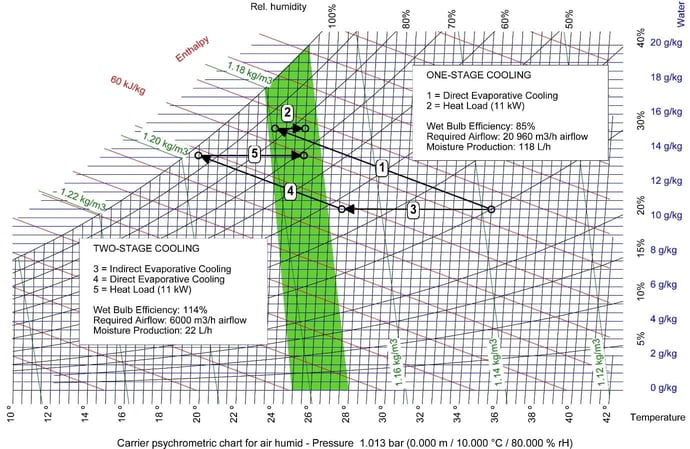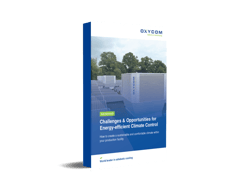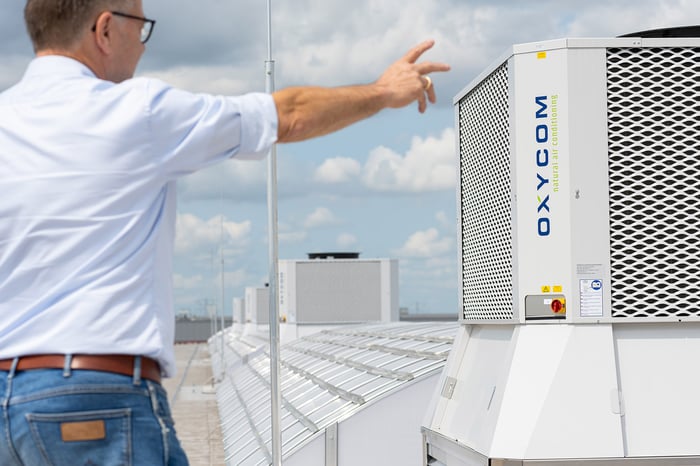Prior advancements in sustainable climate solutions for industrial buildings have resulted in highly energy-efficient adiabatic cooling systems that provide employees with a healthy and comfortable climate. Recently, new developments have added an element of sustainable heating to these adiabatic cooling systems - resulting in a Paris Proof 4-season solution for production facilities and the like. This blog further explains the process of these advanced adiabatic cooling solutions that provide both cooling and heating.
Adiabatic cooling for industrial buildings
Direct adiabatic cooling
In a direct adiabatic cooling system, the air is cooled down by changing the air's humidity as the air is ventilated through wet evaporative media. This highly sustainable cooling solution needs only a little energy for the ventilator plus some water and saves up to 90% energy compared to more traditional cooling techniques. This advantage in cooling down air comes with higher humidity in the air when entering the building.
Two-stage adiabatic cooling
The new two-stage adiabatic cooling technology contains a dry cooling process in addition to an evaporative cooling process. In the first step, the air passes through an air-to-water heat-exchanger, cooling down the air to a lower wet bulb. Thereafter the air passes through wetted media, allowing for deeper cooling (4 to 7°C degrees lower than a direct process). Lower air temperatures can hold only hold a certain amount of humidity, meaning that the air contains considerably less humidity (60 to 70%), thus allowing for more comfort while still saving 90% on energy consumption. An additional advantage of this two-stage adiabatic cooling technology is its functionality in more humid climates.

The graphic shows an example of a one-stage evaporative cooling process vs a two-stage evaporative cooling process with outdoor air at 35 °C and 30% relative humidity. We can see that a one-stage evaporative cooling process produces indoor air with a higher humidity content than a two-stage evaporative cooling process (~80% vs ~69%). Furthermore, the wet-bulb efficiency of a one-stage evaporative cooling process is lower than a two-stage evaporative cooling process (85% vs 114%). Finally, the required airflow to achieve the same indoor temperature of 25 °C at the same heat load (11 kW) is more than 3 times higher in case of a one-stage evaporative cooling process (20 960 m3 /h vs 6000 m3 /h). This implies that the moisture production of a one-stage evaporative cooling process is more than 5 times higher (118 L/h vs 22 L/h).
Heating for industrial buildings
One of the basic principles of thermodynamics states that hot air rises. This isn't any different in a building. Depending on the production process, machinery, and the number of people present, industrial buildings produce internal heat that accumulates underneath the rooftop due to the thermal rise. Consequently, it's often up to 10 ℃ warmer underneath the roof than on the ground below. Using the powerful ventilation fan of the two-stage adiabatic cooling system in winter, the accumulated heat can be pushed back down to the shop floor. To provide added heating, the system can be equipped with an extra heat-exchanger for low temp heating and filters. Note that recovered air should be filtered before being pushed down to the shop floor.
Oxycom's adiabatic cooling and heating
Due to the two-stage evaporative cooling process, Oxycom's adiabatic cooling system, the IntrCooll, provides 4 to 7 ℃ deeper cooling while adding 60 to 70% less moisture to the air, in comparison to other direct evaporative cooling systems. Additionally, the Heat Reclaim module, which can be added to the IntrCooll, will use the accumulated heat underneath the rooftop with freshly ventilated outside air. This keeps the production hall at a steady temperature without creating uncomfortable drafts. If there's no (air) heating system present and the internal heat released from machines is insufficient to achieve the desired temperature, the Heat Reclaim module can be equipped with heating coils. This will heat the recirculated air gathered at the ceiling even further to create a pleasant working temperature during the colder months of the year.
For more information on adiabatic ventilation and heating during winter, read this blog: Sustainable heating and ventilation for your factory during winter.
 Or download our whitepaper “Challenges and Opportunities for Energy-Efficient Climate Control”, and discover how you can create a comfortable and sustainable indoor climate within your production facility, all year round
Or download our whitepaper “Challenges and Opportunities for Energy-Efficient Climate Control”, and discover how you can create a comfortable and sustainable indoor climate within your production facility, all year round
If you would like to know more about the IntrCooll 4Seasons, or the other climate solutions we can offer, contact us at +31 572 349 400, or fill out the form with your question:





